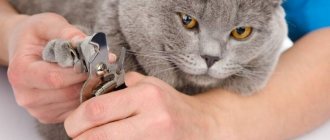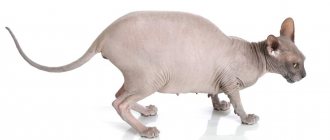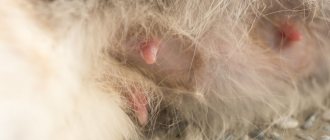11667Administration
1
Cute and affectionate kittens are welcome guests in almost any home. You can watch their games and behavior endlessly. But as soon as the cats grow up a little, the fairy tale gradually begins to become scary. To save yourself from unpleasant surprises, you need to know exactly at what age cats begin to walk.
It should be noted that in these animals, depending on their sex, maturation occurs at different times. Girls, as a rule, reach the age of readiness to go out earlier than boys. If the former can demand “romance” already at six to seven months, then the latter begin to be interested in the opposite sex only at eight to ten months.
It is impossible to confuse the moment when a cat begins to walk for the first time, since the animal’s behavior changes dramatically.
Yesterday's kitten, upon entering childbearing age, stops cuddling and becomes aggressive and angry. The animal may begin to throw itself at its owners, scratch itself, and strive to leave the house, going for a walk in search of adventure outside the door.
© shutterstock
What is estrus
The period during which the behavior of an animal changes dramatically is called estrus, or estrus. At this moment, the process of ovulation begins in the eggs, and conception becomes real.
The following signs signal the beginning of the cat's walking period:
- There are sudden changes in mood. The cat can be overly affectionate, and a few minutes later aggressive;
- The pet meows loudly, calling for a male;
- Transparent discharge appears, the cat licks itself more often;
- Goes to the toilet more;
- Appetite decreases, some cats may refuse food altogether;
- Due to the reproductive instinct, many cats strive to get out of the room, so during the period of heat it is important to close all doors and windows;
- Gait changes appear. The cat bends its front paws and lifts its tail high.
The listed signs during estrus can be observed individually or in combination.
Manifestations of physical maturity
Once they reach puberty, cats begin to behave much more aggressively than male cats. This is expressed in loud screams at night, damage to furniture and wallpaper, and marks throughout the habitat of an animal that has reached a dangerous age. During the period of estrus, the urine of an animal acquires a very pungent and unpleasant odor, it is almost impossible to get rid of it - these are very clear signs of the cat’s puberty. In addition, the beast constantly updates its marks.
The behavior of an animal depends quite strongly on the presence of competitors near it. The more aggressors around, the more nervous the cat began to behave. He hisses and grumbles threateningly, his games resemble hunting.
A loud voice is one way to show rivals who is boss in the house, especially if two animals are in a one-on-one duel.
It should be noted that in addition to being a threat to competitors, cat cries may not be a very good sign. This behavior may be a consequence of the formation of kidney stones in the pet, and not because it has reached a certain age. The sharp edges painfully wound the animal from the inside, causing it to literally scream in pain. That is why any pet’s complaints should be treated carefully and not confuse estrus with a serious problem.
When cats start walking
The main question that worries cat breeders is at what age does a pet go into heat for the first time?
Several factors influence when a cat matures:
- Breed;
- Finding a male nearby;
- Dimensions of the animal;
- Cat color;
- Season.
On average, a cat begins to go into heat for the first time at 6-8 months . However, the process is quite individual and may not start for longer. The start of estrus before one year is considered the norm.
If your pet does not go into heat before the age of 1 year, this is a deviation and you should immediately seek the help of a veterinarian.
The phenomenon known as “erased estrus” is common. In this case, the process of sexual interest is almost not manifested. Most often occurs in unhealthy cats.
How to relieve a cat's suffering?
Currently, there are many drugs on the veterinary market that stop and stop the estrus phase.
These are the means:
- Kowinan;
- contra-Sex;
- sex barrier;
- top-Intimate;
- the ex.
There are often situations when consultants in veterinary pharmacies advise owners who are tormented by the screams of their pets, hormonal drugs that occupy a certain place on the market. They can easily and quickly prevent or stop the phase of sexual arousal.
Their main disadvantage is the negative consequences of use. Hormones negatively affect the condition of internal organs, disrupt the functioning of the thyroid gland, and lead to an imbalance of organic minerals and enzymes.
Due to the use of hormonal drugs for estrus, the following diseases occur more often than others:
- pyometra - purulent inflammation of the uterus;
- malignant neoplasms in the uterus and ovaries;
- breast cancer.
Veterinarians do not recommend the use of such drugs. Sterilization is rightly considered an analogue of hormonal “treatment”. This is a surgical operation that involves removing the reproductive organs - the ovaries and uterus.
In the future, the cat stops “walking” without harm to health, life expectancy increases due to the absence of estrus stress factors in life. The animal becomes more sociable and affectionate, the need for male attention disappears completely.
Veterinarians and breeders around the world urge owners to sterilize females that are unsuitable for reproduction and breeding work. This will extend and improve the life of a particular female, control the number of stray animals, and create clean lines in breeding.
Females are traditionally sterilized before or after their first heat. The operation can be performed at an older age, but by then many contraindications arise. Before the operation, the animal must be examined by a veterinarian. He takes the necessary tests (biochemical and general blood tests), makes a cardiogram and, in rare cases, performs ultrasound diagnostics.
Stages of estrus in cats
There are 4 stages of estrus in cats, each of which is characterized by specific behavior. It should be remembered that it is advisable to match a cat with a male at the second stage, that is, 5-7 days from the start of estrus.
- Proestrus . The initial stage, characterized by restless behavior of the animal (it begins to rub against furniture, bend its front paws). Duration is up to 3 days.
- Estrus . Actually the estrus itself, which can last up to 10 days. During this period, all signs of estrus appear, sexual hunting occurs and the search for a male for fertilization occurs.
- Interestrus . At this stage, there is a decrease in sexual activity, especially if mating has occurred. The cat has a neutral attitude towards cats, perhaps even with aggression. In some cases, a false pregnancy may occur due to the physiological characteristics of the female.
- Anestrus . The final stage, when the instincts fade and the cat returns to its previous life.
How to relieve symptoms of estrus
No cat owner, even the most patient, can like the fact that both day and night his pet, who has entered the breeding age, howls, bites and is overly active and aggressive. At such moments, the question arises of what to do with a cat whose antics can no longer be tolerated.
The easiest way to resolve the issue is to arrange a “date” for the tailed brawler with a suitable cat.
It should be taken into account that you need to choose the most suitable time for mating. The peak of sexual activity in animals whose age allows them to reproduce occurs between February and March. It is at this time that it is more advisable to have offspring, guided by the simplest logic. In the coming summer months there will be no problems with obtaining food for the babies, the cubs do not need to be protected from the cold, and by the first serious frost they will already have reached adulthood.
This path is suitable for owners of purebred animals and those whose cats, having entered adulthood, walk on their own and live in the courtyard of a private house. In a city apartment, a low-bred wild animal can hardly become a prominent and sought-after gentleman. In this case, it is necessary to consider other ways to resolve the issue.
How many days does a cat walk?
One of the main questions that arises for cat owners is how long do they walk? There is no clear answer to this question, since many factors influence the duration of estrus .
The duration of the period depends on:
- Age;
- Time spent without a cat;
- Living conditions;
- Environment, weather, time of year;
- Nutritional features;
- The physical condition of the cat;
- The nature of the pet's body.
In pets, estrus most often lasts from 5 to 10 days. The first estrus may be short-lived . With age, the duration increases, as the pet’s hormonal background forms and changes. In different breeds, a duration of up to 20 days can be observed.
Estrus requires constant monitoring by the breeder. You need to know how long your pet normally goes into heat.
If deviations occur and the heat lasts too long, this may indicate the presence of an ovarian cyst or tumor. A visit to the veterinarian is required to undergo an ultrasound examination.
Sterilization
A pet during the “hunt” can cause a lot of inconvenience to its household members - the animal does not let you sleep and screams at night. And in the future, if it is not planned to breed her regularly, empty heats can greatly harm the cat’s health: such animals often develop various inflammatory processes in the reproductive organs, neoplasms and cancerous tumors.
You should not use chemicals that regulate sexual desire - they will do much more harm than good. Various herbal remedies can come to the aid of owners, however, the effect of their use is quite short-lived - furry beauties quickly get used to them and stop reacting.
With the help of modern methods, the operation is carried out quickly and almost unnoticeably for the animal itself.
We invite you to read: White Heron briefly about the main thing
In rare cases, it happens that a cat walks after sterilization. This happens in a situation where the animal has not completely removed all the ovarian tissue or left the uterus, and the necessary hormones continue to be released. To determine the cause, you need to take hormone tests - the animal may need another operation.
How many times a year does a cat walk?
The frequency of estrus depends on whether the cat has given birth or not. As a rule, cats after giving birth go for walks once every two months, and sometimes once a year. It is impossible to give a definite answer to the question of how long after giving birth the estrus will begin. As a rule, this happens after a month, but it all depends on the specific breed and the nature of the birth.
If the cat has not given birth, estrus occurs quite often - once every two weeks or month. If the owner wants to reduce the frequency of festivities, you can allow the animal to reproduce, or contact a veterinarian to prescribe hormonal medications.
Duration of estrus in different cat breeds
The duration of estrus directly depends on the breed of the pet.
British women are known for the rarest periods of festivities. The first heat occurs at the age of 7 months. Over time, the regularity of ovulation and its duration are disrupted;
Scottish women are famous for their early puberty - at 5 months. The duration of estrus is up to 6 days, the frequency is several times a year.
What determines the maturation of an animal?
It is worth noting that it is impossible to say with absolute certainty that a cat begins to walk at 8 months, since, like in humans, in cats this process occurs with individual characteristics, in which age is not the main indicator. It’s easier to focus on some general rules:
- The age of maturation depends on the breed, some of them cause earlier or later onset of sexual heat;
- This factor is also influenced by the structure of the skeleton; more fragile and graceful animals are earlier ready for reproduction;
- The time of birth also influences puberty; a cat reaches sexual maturity from a winter or spring litter as early as the next season, while later-born animals may take a little longer to mature;
- Cats kept in the most comfortable conditions are ready to give birth to offspring much earlier;
- An animal that finds itself in an environment consisting mainly of adult animals will itself mature faster;
- In many animals, the early search for satisfaction of their needs is explained by a common genetic predisposition.
In any case, when the age gets closer to a year, any animal will already begin to show signs indicating the onset of childbearing age.
What to do if your cat doesn't walk
One of the deviations is the absence of estrus in a mature cat. Besides a visit to the veterinarian, there are several ways to help your pet:
- If there is a pet in the neighborhood who is in heat, he needs to be housed. As a rule, cats leak at the same time.
- If there is a cat nearby, it is also advisable to bring the animals closer together. If there is a male, the maturation of the egg will occur faster.
- If the cat is healthy, you can give vitamins and homeopathic remedies.
Alternative ways to resolve the heat issue
Modern pharmacology can offer pet owners to discourage their animals from any desire to flirt with the opposite sex, preserving their reproductive function. In this case, it is proposed to use two types of drops:
- Sedatives (in addition to ready-made pharmacy options, you can use folk methods in the form of chamomile or thyme decoctions);
- Hormonal (they will calm a walking animal by adjusting the animal’s hormonal levels).
If the animal is not valuable as a breeder, it is better not to torture it and castrate the cat. Unlike people, animals do not grieve over the loss of the opportunity to bear offspring, so the pet will not receive any mental trauma, but only peace for itself and its owners.
IMPORTANT! VETERINARIAN CONSULTATION REQUIRED. INFORMATION FOR INFORMATION ONLY. Administration Share with friends Article rating
Average age
In veterinary medicine, there are two parallel concepts: sexual maturity (the moment the egg first matures) and actual maturity (the time when a cat is anatomically and physiologically capable of becoming pregnant, bearing and giving birth to viable kittens). The main difficulty is that these periods do not occur simultaneously and a cat can become pregnant before giving birth to healthy kittens.
The average age at which a pet shows the first need for contact with an individual of the opposite sex usually occurs in the first year of life: from 8 to 11 months. Often, in practice, these dates may shift somewhat, so the situation is considered normal when the animal goes on a spree for the first time at the age of six months.
Why is it harmful to walk with a newborn?
What is stress?
- A newborn is not able, like an adult, to maintain body temperature on his own, especially during sleep; his thermoregulation system is imperfect. Therefore, the child has to be dressed in numerous layers of clothing, and even then he spends too much energy maintaining his temperature. Deep sleep outside allows the child to save energy - this is the first reason to immerse himself in it when the ambient temperature is low.
- When walking in a stroller, the child is not close to his mother, he does not feel her warmth or smell. This is contrary to the needs and expectations of the newborn. The street environment frightens the baby; a large number of visual, vestibular, and tactile stimuli overload the nervous system. This is another incentive to “switch off” and fall asleep deeply.
- There is too much oxygen outside for a baby in the first months of life, and this also leads to deep sleep. Remember how you sleep in a country house in the forest after a working week.
Here are at least three reasons that force a child to fall into a sound sleep. But physiologically, a newborn and a child in the first months of life should be in deep sleep only 20% of the time. As a result of sleeping on the street, the rhythms become confused, and superficial sleep disappears. This is precisely what is harmful for the development of the child’s brain - because it occurs in this phase of paradoxical sleep.
The baby can also skip feeding, because outside he can sleep for 3 or 4 hours. If this situation repeats regularly, and the mother goes for walks every day in any weather, then the baby does not receive enough breast milk. Up to three months, daily 3-4 hour gaps between feedings can lead to decreased milk production and insufficient weight gain by the baby. And if the child wakes up, it is almost impossible for a mother to organize proper feeding on the street, especially in the cold season, so she will either intensively rock the baby in a stroller or offer him a pacifier.
Observations of a large number of children show that those babies who did not walk in the first months of life are no different from their peers who slept outside. And even vice versa: as a result of gentler and more proper care, they are mentally and physically healthier.
When can you take your first walk?
So when should you start walking your newborn after leaving the hospital? Many mothers begin to visit the street the very next day after returning home, especially if it is late spring or summer. However, pediatric neonatologists have a different idea from the widespread idea among young mothers that the sooner you take the baby out into the air, the better it will be. Their professional recommendations on when to start walking your newborn outside are very clear and unambiguous.
They insist that you should start going out with your baby no earlier than the second week after birth. That is, starting from the moment when the baby has already become a little accustomed to the new environment. In this case, you need to start with 15 minutes of exercise, adding 10 minutes daily to the total time spent outside. But the total walking time should be 2-3 hours a day: longer in summer, shorter in winter and autumn. In winter, you can take walks for 1.5-2 hours, but if the temperature drops below -10 degrees, it is better to skip going outside and just let the baby sleep on the balcony. To prevent your child from freezing, dress him warmly enough. In this case, the balcony must be glazed.
What is the benefit for the baby?
Mothers of children who were born in the warm season are not too concerned about how to start walking with their newborn in the summer. After all, during the hot period, they can only worry about making sure that the child does not sweat excessively. But parents of “winter” kids have enough questions. Is it even worth going for a walk with your child if it’s cold and piercing wind outside? How to dress your baby correctly and how long to walk with him in the cold? How to protect him from colds? Everyone is especially interested in the question of when can you start walking with your newborn in winter? Let's consider what rules should be adopted in different situations and seasons.
The first walk together with a baby is a very serious event, so you should be well prepared for it. And to understand its importance, you need to know why the baby needs these walks. What are the benefits of being outdoors? Walking is not just useful, but necessary, because it:
- gives the child good training;
- increases his immunity, and also develops the child’s body’s resistance to pathogenic bacteria;
- stimulate the development of the nervous system;
- saturates cells with oxygen;
- improves metabolism;
- provides the child’s body with the necessary amount of ultraviolet radiation, which helps in the production of vitamin D, which is so necessary for children;
- involves a variety of different objects that the baby encounters on a walk, trains his vision;
- develops the communication experience necessary for the child’s proper emotional development;
- affects the improvement of appetite;
- accelerates blood circulation;
- improves baby's sleep.
After a walk, the child becomes calmer and sleeps better. In addition, constant changes in temperature outside help the child’s body quickly adapt to the impermanence of our world. Staying in the sun helps to stock up on vitamin D, which prevents the development of rickets.
Spring and autumn. Baby's first walk
Now let’s look at when to start walking with a newborn in the fall or early spring. During this, still quite cold time of year, you can almost always walk with your baby, only excluding those days when it rains heavily or cold winds blow. These walks can be quite long - 2-3 hours. At the same time, you can use your walking time either at one time or by dividing it into periods of 40-50 minutes. When bad weather is raging outside, it is better for the baby to stay on the balcony and get his portion of oxygen while being safe. Yes, and mom can do something around the house at this time.
Summer and baby's first walk
When can you start walking with your newborn in the summer? After all, in the warm season the adaptation period is reduced? A baby born in summer goes through an adaptation period in about 5-7 days. How to start walking with a newborn in the summer? His first outing should last no more than 10-15 minutes, all subsequent walks should be increased gradually by 10-15 minutes so that by the age of two months the baby can walk for at least two hours a day. This time must be divided into two equal parts and go outside in the morning and in the afternoon. You should avoid walking with your newborn if the air temperature is above 27-30 degrees.
Clothes for spring and autumn
When your little one gets older, start teaching him to go for walks while he is awake. At the same time, he can sleep in a stroller on the balcony when the walk does not take place for some reason. Having figured out when you can start walking with your newborn baby in the autumn-spring, it would not be a bad idea to dwell on what form of clothing you should give preference to. During the off-season, the weather can change very quickly, and that gentle sun in which you went for a walk can suddenly turn into a piercing wind. For this reason, when going for a walk, you need to be prepared for any weather surprises. Clothing should be waterproof and well protected from the wind.
Duration of walk in spring and autumn
The first walk for children born in autumn or spring should take place no earlier than a week after your discharge from the hospital. It should last only 10-15 minutes on the first day and constantly increases from exit to exit. The duration of walks depends on weather conditions and is set by parents independently - in warm weather, you can walk longer than expected if the child behaves calmly and is not capricious. On colder days, walking can be reduced to a minimum.
Given the surprises of the weather, you will have to combine different elements of children's clothing. To do this, you should buy your child several walking overalls, different in density, as well as blouses - woolen and lighter fleece, one thin underwear cap and 2-3 warmer hats. In addition, you will also need an outdoor overalls with a removable lining or an envelope. You should dress your baby just one layer warmer than an adult.
In inclement weather, a raincoat is highly recommended. But it should only be used in emergency cases, so you can get home without getting wet. Considering the fact that the air is thin in the rain and is very useful for the baby, you can walk with him during the rain under some kind of canopy. When used for a longer period of time, a raincoat creates a greenhouse effect in the stroller, which accumulates moisture and leaves no room for oxygen.
Expert advice
The owner’s desire to nourish his pet with vitamins for the normal course of physiological processes must be accompanied by the knowledge that there are products for cats (for example, “Irish Cal”). Medicines aimed at people are not suitable for them.
To stimulate estrus (if it does not occur in the cat), vitamin E is prescribed, as well as the products “Katozal”, “Ovariovit”, “Ovarium”, “Compositum”, “Ortilin”, “Gamovit”. For the same purpose, the cat can be placed in the same space with a neutered cat or with a cat who is in heat.
Vitamins can help us...











